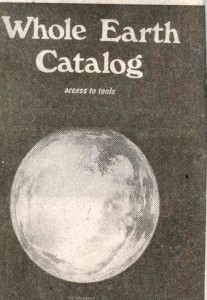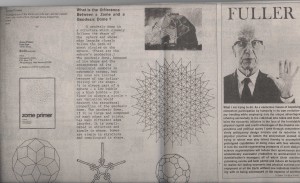I wrote this in 1999
By June Morrall
Story by June Morrall
Menlo Park: 1968. The first issue of the Whole Earth Catalog caught the moment. People tingled at the prospect of man’s walk on the moon, and the over-size black catalog cover art-work captured that anticipation with its memorable photo of our world taken from the heavens revealing Spaceship Earth.
By 1971 the Catalog was wildly successful, and that same year, its creator, Stewart Brand, shocked readers by pulling the plug and closing it down.
“I was exhausted,” Brand explained in an email, “and I wanted to see what would happen when you just stop a success in midstride.”
In the late 1960s if you were building a geodesic dome, fascinated by how windmills work or repairing a small gasoline engine, the Whole Earth Catalog was required reading.
Subtitled “access to tools,” the Catalog lured readers into newsprint pages filled with book reviews, accompanied by photos, sketches and diagrams on subjects as diverse as the inhabitants of the planet.
Aimed mostly at young adults, the broad range of information gathered a loyal following, some of whom submitted their own reviews and articles.
A graduate of Phillips Exeter Academy and Stanford University, Stewart Brand, a self-styled social sector entrepreneur, described the original non-profit startup catalog as a do-it-yourself of all kinds.
If Brand was the entrepreneur, the catalog’s guru was the visionary R. Buckminster Fuller, perhaps best known for his invention of the geodesic dome, an architecturally challenging structure. The catalog gave popularity to the dome as young hippies erected the unorthodox creations in remote areas, often without building permits.
Fuller, who coined the concept “Spaceship Earth,” recently had his blueprints, papers and videotapes acquired by Stanford University. He believed that information should be shared with everyone for the benefit of society, a creed shared by the Whole Earth Catalog. No surprise that Fuller remains synonymous with Brand’s famous publication.
The Catalog brought about a renaissance, explained Dan Rosset, a Redwood City woodworker, who has kept a complete collection of them. He considers the Whole Earth Catalog an educational publication filled with new ideas.
“It provided the access to tools,” Rosset said, “and by tools, I don’t mean hammers and pliers–tools are a way to access information. It exposed readers to ideas which were later brought to the masses.”
The Catalog was often portrayed as a resource for the counterculture hippies living in rural communities, but Brand insisted it was not primarily a back-to-the-land publication.
Carol Goodell, who contributed book reviews to the original catalog agreed. “It was a way to do you own research and teach yourself. The catalog blurred the lines between vocational and formal education,” said Goodell, a Stanford Ph.D, and former teacher who when this story was written in 1999 operated Carol Goodell & Associates, a San Mateo-based counseling service for college applicants.
Goodell pointed to the cultural revolution that took place in the late 1960s. “The Vietnam War, women’s liberation and the civil rights movement, combined with the excitement of space exploration, all brewed to shake the foundations of society.”
Staid Ivy League colleges were going co-ed. All educational institutions offered innovative programs to attraction non-traditional students. The profile of the average student was changing, with many of them now adults.
Enter the non-profit Portola Institute in Menlo Park. It provided support and seed money to alternative educational projects, such as Stewart Brand’s Whole Earth Catalog.
Goodell and her partner in “Real World Learning, Inc.”–came to the attention of the Portola Institute at the same time Brand was starting up the Whole Earth Catalog. They were aware of her work in the field of education, including her development of role-playing games for elementary and high school teachers that took the partners from coast to coat conducting seminars. Her anthology, The Changing Classroom, had just been published–a path-breaking effort–and Brand wanted her to write book reviews for the Catalog.
Goodell reflects on an early meeting with Brand when he asked her opinion about a new book in the area of education. After a spirited exchange, he said: “Now sit down and write what you just told me.” Thus began Goodell’s work as a reviewer for the Catalog.
Goodell was older than most of the other people employed at Whole Earth. Her husband worked for IBM and they had two young children.
In 1999 when this story was written, Carol Goodell was in her 60s. As she looked back to those early days at the catalog, she admitted she might have preferred straight-laced corporate types. About the people she worked with, Goodell said: “We had common educational values but different life experiences.”
In other words, she was straight and they were hippies.
Yet, within the Portola Institute’s think-tank atmosphere, everybody was interesting and there was a strong work ethic, although some of the people were off the wall. It was a place where a lot of ideas were flying around with great passion.
Carol Goodell summed it up: Whole Earth “was a place for lovers. Everybody loved what they were doing.”
Asked about Stewart Brand, she said he looked as if he should be wearing a yachting cap. He was the leader, he thought self-teaching was important and he was way ahead of the times.
Overseeing the Portola Institute was Dick Raymond, a former Stanford Research Institute employee. Goodell recalled this important figure as a handsome, sun-tanned fellow, a twinkle in his eye, with a nice mix of compassion, enthusiasm and realism. Raymond’s role was to ferret out the most doable ideas.
He possessed the talent to recognize other people’s abilities, Goodell said. He could repair the plumbing and teach you how to negotiate a contract.
It was Raymond who identified the promise in Brand. But they were unable to come up with the right project until Brand hit upon the notion of an “access catalog.” A good listener, Raymond peppered Brand with questions such as “Who’s the audience? How much will it cost? Where will it be distributed?” Brand didn’t have all the answers, but he knew he wanted to call it the Whole Earth Catalog.
The Catalog was launched at 558 Santa Cruz Ave in Menlo Park, a comfortable suburb near Stanford. The building formerly housed a WWII USO and later the Salvation Army. The store-front read: Whole Earth Truck Store & Catalog, a division of the Portola Institute: it was Brand’s clever idea to add the location’s latitude and longitude.
Brand’s office was draped in an orange parachute and in the email to me, he remembered: “Much of the furniture was nailed together by the staff. In the retail front, books for sale had holes drilled through them and were hung on the wall on headless nails. Some products mentioned in the Catalog were sold as well. Since nobody had experience in running a retail store, it became on-the-job training.”
Goodell recalled seeing scribbled on customer receipts: “Thanks for the bread, man.”
The store also became the production center for the Catalog–with type set by hand–but it was printed at nearby Nowell’s Publications.
Distributing the Catalog proved difficult as its large size presented a problem for bookstore owners who didn’t know where to display them. Subscriptions were slow in coming and a grand opening at the store to which the press was invited flopped.
Morale was flagging and then the Whole Earth Catalog caught the fancy of “big media”: Time, Vogue, Esquire.
[In todays parlance, the Whole Earth Catalog was “cool.”]
Flattering coverage brought fresh subscriptions, but the biggest response came from one tiny mention in “Uncle Ben Sez,” a column appearing in the Detroit Free Press, according to a 1972 Pacific Business article authored by Stewart Brand. A reader asked: How do we start a farm? and Uncle Ben printed the address of the Whole Earth Catalog in Menlo Park. Hundreds of subscriptions poured in.
The Catalog became a national success story.
Brand said, then as now, the Mid-Peninsula was an easy place to start things. But it didn’t make him rich, as the media often reported. Brand said he received a non-profit salary.
By mid-1972, an exhausted Brand announced that there would be an exclusive party to celebrate the DEMISE of the Whole Earth Catalog in San Francisco.
After the DEMISE party, Brand said, when overhead went to zero, royalties rolled in for months. The Point Foundation was created to give away more than $1 million in three years, with the recipients as diverse as environmental groups and COYOTE, Margo St. James’ union for prostitutes.
When Random House representatives came to Menlo Park, perhaps to negotiate acquisition of the Catalog, they presented a contrast to the more casually attired crew at 558 Santa Cruz Avenue.
The men from the giant publishing house, wearing nice suits, ties, and wing tip shoes, walked into a room where a young woman employee nursed her infant on an old couch, with the springs popping through the worn fabric.
During the talks, Goodell recalled, people floated in and out, dressed in hippie clothes, but production of the Catalog never ceased, and there was a clattering in the background. The men from Random House fingered their collars but never loosened their ties in the intimate environment.
“Five years earlier, I definitely would have identified with the corporate types,” Goodell said, “but now as part of the Catalog, the strange comings and goings seemed quite normal.”
In 1999, when this story was written, the storefront that once house the Whole Earth Catalog was home to Wessex Used Books & Records, specializing in fiction, history and scholarly works.
Owner Tom Hayden said that he used to get letters from all over the world asking for the latest Catalog. All that’s left of Whole Earth was faint evidence of their photographic darkroom.
Brand moved on. He joined Governor Jerry Brown’s administration, lived for a time in a funky houseboat; more recently (1999), he founded the web site called the WELL and co-founded Global Business Network.
Some people have characterized the Whole Earth Catalog as ahead of its time. In 1999, when Stewart Brand was in his 60s, he said: “I don’t think ahead of its time ever means much. The Catalog was new in several ways. It was a conspicuous success. Success often becomes commonplace soon.”


